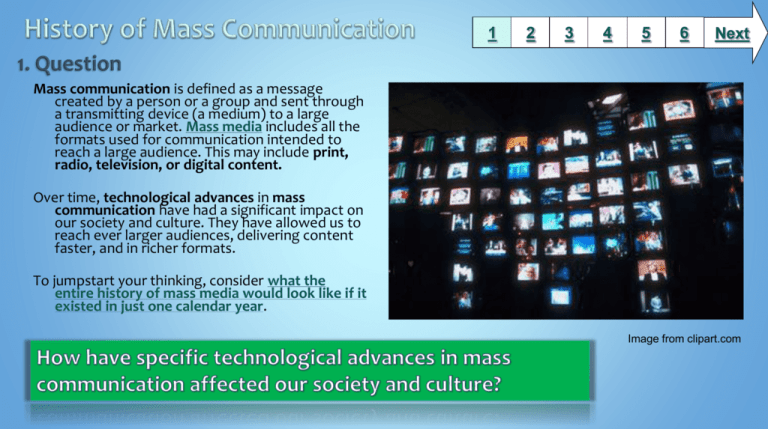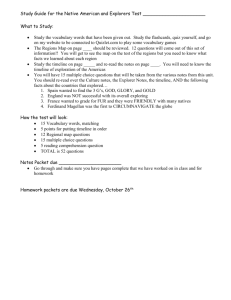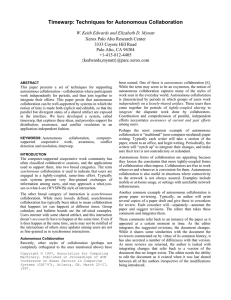
1
2
3
4
5
6
Next
Mass communication is defined as a message
created by a person or a group and sent through
a transmitting device (a medium) to a large
audience or market. Mass media includes all the
formats used for communication intended to
reach a large audience. This may include print,
radio, television, or digital content.
Over time, technological advances in mass
communication have had a significant impact on
our society and culture. They have allowed us to
reach ever larger audiences, delivering content
faster, and in richer formats.
To jumpstart your thinking, consider what the
entire history of mass media would look like if it
existed in just one calendar year.
Image from clipart.com
1
Students will be assigned to individually research one
of the four different types of media: print, radio,
TV, or the Internet.
Resources for print research:
World Book: "Printing."
The News: Newspaper, the History from Thinkquest
“Johannes Gutenberg and the Printing Press”
Resources for radio research:
World Book: “History of Radio Broadcasting and
Development ”
“Podcasting History”
FCC: History of Radio
"Radio." Berkshire Encyclopedia of World History
2
3
4
5
6
Resources for TV research:
World Book: “History of Television Broadcasting”
FCC: History of TV
Kids Work: The Invention of Television
Resources for Internet research:
World Book: “Internet”
The Internet Society: Brief History of the Internet
Consider the significance of key events in history as
you take notes and mark them with a star.
Cornell Notes
Next
1
2
3
4
5
6
Next
Once the individual background research on the
media source is completed, students will jigsaw
into 4 collaborative groups. Groups will then
create a timeline of the most significant events in
the development of mass communication for our
society and culture.
Each event on the timeline should include a specific
date and a brief explanation of the
development’s importance to mass
communication. Groups will share their timelines
with the class for evaluation and comparison.
Use one of these tools to organize your timeline:
Printable Timeline
Create a Timeline using Microsoft Excel 2007: Tutorial
TimeToast
TimeRime
Your group timeline presentation will be assessed
using this rubric.
Image from clipart.com
1
2
3
4
5
6
Next
After presentation, students will compare the four
different timelines to evaluate and assess
which events were most significant to our
society and culture.
Students will compose a written argument
explaining which events were most significant
and why. Be sure to include support from your
own research as well as the other group
presentations.
Your argument will be assessed using the 6 Traits
of Writing Rubric for constructed response.
Image from clipart.com
1
2
3
4
5
6
Next
Additional resources related to the history of
mass media.
Television: Window to the World on Safari
Montage
Days That Shook the World Series 1: Concorde/
Marconi Chapters 1-3 on Safari Montage
The Timewarp Project: Use the Timewarp tool to
search for artifacts in mass media history.
Paley Center for Media: Includes resources for
educators, current events, and perspectives on
media.
Visit a local museum in person or virtually to explore
the artifacts in their collections.
The Radio and Television Museum
Museum of Radio and Technology
The Newseum
Image from clipart.com
For Homework: What does the progression in
information technology and access suggest about the
future of communication? Support your predictions
with reference to your research or prior knowledge.
1
BCPS Curriculum
O-2 Students will recognize the influence of mass communications in their daily lives, understanding
both its positive and negative effects, and will recognize elements and uses of bias in the media
in order to make ethical choices in the development of products and productions.
KSI-A Investigate the development of communication technology and discuss its impact on society
and culture
Maryland State Curriculum
Standard 4 Students will compose in a variety of modes by developing content, employing specific
forms, and selecting language appropriate for a particular audience and purpose.
Indicator 2. Compose oral, written, and visual presentations that express personal ideas, inform, and
persuade
Common Core State Standards
Reading: 1. Read closely to determine what the text says explicitly and to make logical inferences
from it; cite specific textual evidence when writing or speaking to support conclusions drawn from
the text.
Writing: 7. Conduct short as well as more sustained research projects based on focused questions,
demonstrating understanding of the subject under investigation.
Writing: 9. Draw evidence from literary or informational texts to support analysis, reflection, and
research.
Standards for the 21st Century Learner
1.1.6 Read, view, and listen for information presented in any format (e.g. textual, visual, media,
digital) in order to make inferences and gather meaning.
2.1.3 Use strategies to draw conclusions from information and apply knowledge to curricular areas,
real-world situations, and further investigations.
Maryland Technology Literacy Standards for Students
3.0 : Use a variety of technologies for learning and collaboration.
2
3
4
5
6
Time Frame:
Three 50 minute class periods for research, timeline creation,
presentation and assessment.
Differentiation:
Direct students to use comprehension tools included in
databases, such as: audio read-aloud, labeled reading
levels, and embedded dictionaries. Whenever possible
reading materials have been linked through the
databases to provide this support.
Gold and silver stars indicate difficulty of reading
material.
Learning Styles:
Field Independent, Visual, Auditory, Tactile, Active, Global
AVID Strategies:
Cornell Notes
Notes to the teacher:
To use TimeToast or TimeRime, consult with your School
Library Media Specialist to set up an account.
Tips for using the Cornell Notes strategy.
Last update: July 2015
Created by Natalie Avallone
BCPS Research Module or Slam Dunk Model, Copyright 2015, Baltimore County Public Schools, MD, all rights reserved. The models may be used for educational, non-profit school use
only. All other uses, transmissions, and duplications are prohibited unless permission is granted expressly. This lesson is based on Jamie McKenzie’s Slam Dunk Lesson module available
at http://questioning.org/module2/quick.html.






